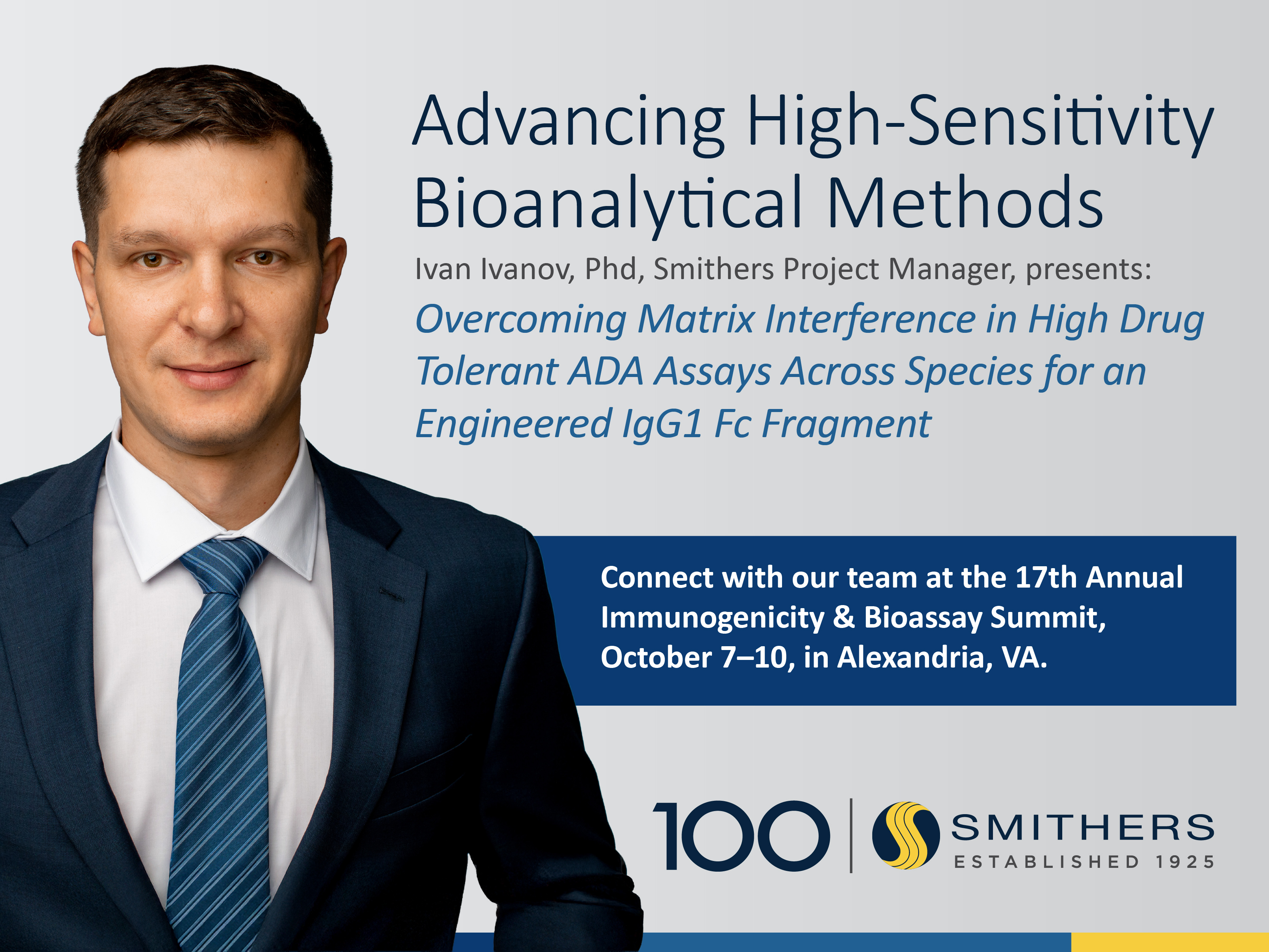
Overcoming Matrix Interference in High Drug Tolerant ADA Assays: Smithers to Present at the 17th Annual Immunogenicity & Bioassay Summit

Smithers Pharmaceutical Development Services (PDS) is proud to highlight the work of our specialist Ivan Ivanov, PhD who will be presenting a poster at the 17th Annual Immunogenicity & Bioassay Summit, taking place October 7–10 in Alexandria, Virginia.
His poster, “Overcoming Matrix Interference in High Drug Tolerant ADA Assays Across Species for an Engineered IgG1 Fc Fragment,” addresses one of the most pressing issues in immunogenicity testing today: reliably detecting anti-drug antibodies (ADAs) in the presence of high drug concentrations.
The introduction found within Ivan’s poster explains the scope of what he will be presenting: “Fc receptors have gained significant attention as therapeutic targets in autoimmune diseases. NVG-2089 is a recombinant, engineered IgG1 Fc fragment designed to bind type II Fc receptors and promote anti-inflammatory effects. The molecule’s high degree of sialylation and high intravenous dosing regimen pose unique bioanalytical challenges in anti-drug antibody (ADA) detection, particularly due to matrix-specific interference and high circulating drug levels.”
See the Poster in Alexandria
The Immunogenicity & Bioassay Summit is the ideal venue to share these results with the broader community, and Ivan’s poster will provide real-world examples of strategies to address matrix interference and expand drug tolerance in ADA assays, offering practical takeaways for researchers, method developers, and program leaders alike.
17th Annual Immunogenicity & Bioassay Summit
October 7–10, Hilton Alexandria Old Town, Alexandria, VA
We invite you to stop by Ivan’s poster session, meet him in person, and learn how Smithers can help advance your most complex immunogenicity programs.
Understanding the Challenge
Traditional ADA assays often struggle when drug levels in the sample are unusually high. In these situations, drug molecules can mask or mimic immune responses, leading to inaccurate readings and undermining the reliability of the data. This was precisely the challenge faced by one of our sponsor partners, who required a method with significantly greater drug tolerance than standard assays could deliver.
Smithers’ team accepted the challenge and began development in mouse models. While the approach worked in one species, it quickly became clear that each animal system presented its own unique sources of matrix interference. The team recognized that methods could not be assumed to work universally and would require thoughtful optimization for every new model.
Why Engineered Fc Fragments Matter
The therapeutic at the center of this work is an engineered IgG1 Fc fragment. Unlike full antibodies, Fc fragments represent only part of the molecule, creating novel complexities for ADA assay design. These therapeutics are still relatively new in the clinic but hold great promise, making it all the more critical to ensure assays are capable of supporting their development.
Because engineered fragments behave differently from conventional monoclonal antibodies, the Smithers team needed to push the limits of drug tolerance far beyond what generic ADA assays typically handle. In fact, the required tolerance was many times higher than the levels supported by conventional methods — a leap that demanded innovation across assay design, buffer systems, and detection strategies.
Expanding the Boundaries of ADA Assays
Through systematic testing and refinement, Smithers successfully developed methods that maintained sensitivity and accuracy even under extremely high drug concentrations. The project underscored an important lesson for the field: success in one context does not guarantee success in another. Every species, therapeutic type, and matrix environment presents distinct challenges, and assays must be adapted accordingly.
The work also revealed practical approaches to assay modification that can be applied across therapeutic areas. From monoclonal antibodies to next-generation biologics and cell or gene therapies, the strategies developed here provide a roadmap for sponsors who need high drug tolerance and robust ADA detection.
Why Sponsors Choose Smithers
Projects like this exemplify why sponsors come to Smithers. Our team has a long track record of stepping in when others cannot solve the problem, combining deep scientific expertise with a collaborative, solutions-focused approach. This study required the full spectrum of talent within our PDS group — from senior scientific directors to bench scientists — working together to overcome one of the toughest challenges in immunogenicity testing.